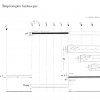Impromptu fantasque
Impromptu fantasque for six recorders, three or six mandolins, three or six guitars, percussion and piano (1973)
{slider=Impromptu fantasque for six recorders, three or six mandolins, three or six guitars, two percussions and piano /fragment/}
National Philharmonic Orchestra, cond. Jan Krenz „Warsaw Autumn” 1974
{/slider}
A work with an unusual performer line-up, it heralds Serocki’s experiments with the sound of the recorder continued in Concerto alla cadenza and Arrangements. The delicate colour of the recorders (sopranino, soprano, alto, tenor, bass and great bass) is combined here with the timbres of plucked string instruments (mandolin and guitar) and selected colours of the percussion instruments and the piano. This juxtaposition often produces surprising combinations of sounds, impossible to recreate in another instrumental environment.
The timbral innovativeness of the composition can be found in its articulations, which are unconventional in themselves. For instance, the guitarists and mandolinists play the strings between the fingerboard and the peg or between the bridge and the saddle; they perform “tremolo glissandi” and quasi-harp arpeggios. The pianist has to play a whole variety of clusters and also plays the strings directly. On the other hand, the percussion set is used by two performers, who have at their disposal instruments with specific pitches as well as numerous idiophones and drums.
The work’s notation is not completely determined, for the marked time sections are just approximate and there are many sections characterised by rhythmic freedom. In this respect the composer gives a free hand to the performers, suggesting only that they try to achieve “the biggest possible temporal-rhythmic variety”. What also contributed greatly to the work’s success with the audience (it was encored during the “Warsaw Autumn”) was its carefully planned form, full of tensions and relaxations, solo and ensemble vicissitudes constantly fuelling the audience’s imagination.
{slider=Sources:}
- Tadeusz A. Zieliński, O twórczości Kazimierza Serockiego [On Kazimierz Serocki’s Oeuvre], Kraków 1985.
{/slider}





